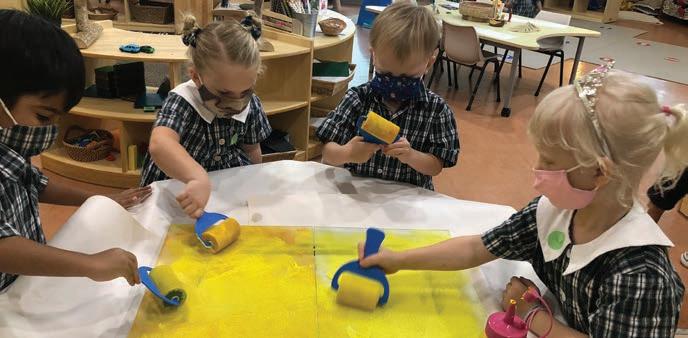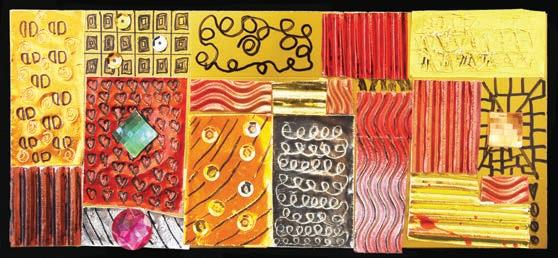
6 minute read
Student Art Showcase
O W C A S E S H
Roll With It
by Libby Henderson, Head of Art & Design (Infant)
“All Infant School children have had the opportunity this academic year to work with Stephanie Wijaya, STLA in Art & Design. This term, it was the turn of the Nursery children. Their focus was on printmaking; techniques such as mono printing and stencilling were explored using a range of tools such as rollers, acrylic and foam boards. Through this activity, the children explored colour, observing what happened when they were mixed together, and creating patterns, textures and shapes of insects to represent each class. The result was wonderful, collective art that inspired and provoked the imagination.”






Izumi 4.2

Sebby 4.4

Naisha 4.5
All That Glitters
by Peter Hinckley, Head of Art & Design (Junior)
“Using Gustav Klimt’s famous painting, Portrait of Adele Bloch-Bauer I, as an inspiration, Year 4 children enjoyed creating their own Klimt-style mixed media collage art.
The project began with discussion and close observation of Klimt’s skilful use of shapes, patterns, symbols and shimmering colours, after which the children made preliminary sketches of their own ideas for a collage composition. The objective was to be inspired by Kilmt’s artwork, while creating their own individual interpretation of his style.
Having evaluated their design sketches, the children worked progressively on creating their own original piece of art that showcased a range of different textures, colours, lines and shapes through use of card, paper, fine liners, and acrylic gemstones.”

Ella Sia 4.6

Valentin 4.8

O W C A S E S H



“Cubed”, Haochen, Year 13
“ປະເທດລາວ (Laos)”, Maria, Year 13
“Draped Ink,” Mia, Year 13
In 2020, the annual IN Art Exhibition was due to celebrate its 10th year at the Australian High Commission, when local restrictions forced its cancellation. A collaboration between 16 international schools in Singapore, IN has been a significant showcase for student art for a decade, and one IN co-founder, and Head of Art & Design, Rob Le Grice was determined should still take place this year.
As with many other aspects of our lives in a pandemic, the exhibition moved online; the look of the specially created website was elevated significantly by the creative talents of Eva Stanistreet, Technical Executive in the Senior School’s Arts Faculty, while the content was curated by teachers across the 16 participating schools.
The process of assembling students’ artwork would usually have taken place in the gallery itself, with staff collaborating to create relationships between each piece. Done virtually, the exhibition could not be constructed in the same way but, as Rob explains, there was still very much a collective vision for it.
“After 10 years, it’s got to the point where staff know each other very well; we are a tight team,” he tells. “What’s interesting is that each of the schools has its own strengths, and we are able to put together a show with enormous variety if we simply bring along work that exemplifies what we are good at.”
“At Tanglin we have a reputation – and we are very proud of it – for using unusual materials, and using a wider variety of materials. Some might call it a textural, experimental approach. We like the notion of blending traditional and contemporary materials and techniques.”
Having a platform to share this unique style was one of the catalysts for starting IN, in 2010. Prior to that, Rob recalls Tanglin hosting art teachers from local schools for their professional development and noting several visitors were surprised by the range of student artwork on display.
“I fielded more than a few questions along the lines of, ‘How do you do that?’ When I explained our approach, I could see there was an interest but ultimately, just describing it wasn’t enough. I thought, ‘These discussions aren’t getting us far; let’s have an exhibition and get the message out there, physically.’ While IN isn’t about Tanglin – it’s about a number of different schools – there was certainly a spark here to initiate that curiosity about the ways in which you can ‘teach’ creativity.”

As in previous years, the artwork Tanglin contributed to IN 2020 was drawn from a longlist of GCSE, A Level and IB exhibitions from the previous summer. “We tend to make large, flourishing displays that are either a mixture of sculpture and photography, culturally authentic materials, or very contemporary craft,” says Rob. He acknowledges that Tanglin’s relatively small class sizes give staff and students alike more scope for experimentation. “There can be a rather quirky range of materials on display and to a certain extent, the community recognises that,” he says. overseas to see their work exhibited. “It was a way of doing justice to their talents,” Rob tells. “We had to make sure the look of the website could match the quality of the artwork – and we are lucky enough to have Eva, who was able to take it to the next level, both visually and technically. We were very aware that, being in an online gallery, the exhibition would be shared more widely than ever before.”
Despite its success, however, Rob believes IN works best as an exhibition in the traditional sense; he hopes it will once again open at the Australian High Commission in the autumn. “Previous exhibitions have allowed families to look at works by a Tanglin student, and students from other schools together, and that is where connections and relationships have formed,” he says. “When students meet at our celebration party, they often exchange numbers and contact each other about their work, and we find many students remain in touch long after the exhibition closes.”
“While the website will remain next time, we are hoping we will also be able to open a physical gallery again. There really is nothing quite like it.”
“It amazes us how emotionally mature 17- and 18-year-olds’ art can be. I [have been] interested to see how the Coronavirus pandemic has affected the art... I was thinking that the time at which a lot of the students would have been conceiving of their artworks may have been around the time of the Circuit Breaker. What was the presiding emotion of that time? It was fear, it was grief; it was loneliness, in some cases. Now we have the news that vaccines are on the way, what happens with art? How does that hope affect it?” – Rachel Dunstone, Acting Deputy High Commissioner, Australian High Commission (as told to Rob Le Grice at the opening of the IN Art Exhibition)










